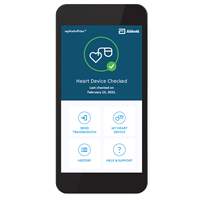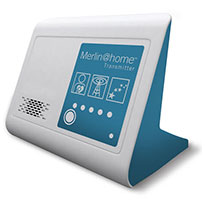Manage your device ID Card
Keep your ID card information updated so you can always get the best care possible when you need it.
An implantable cardioverter defibrillator, or ICD, is a device used to continuously monitor and help regulate fast heart rates. When an ICD senses an arrhythmia, it delivers a shock to your heart to reestablish a normal rhythm. It also stores important information your doctor can use to program your ICD so you can receive the best possible treatments and therapies. All Abbott defibrillators are both pacemakers and ICDs, offering both features in one device. The difference is that an ICD delivers a shock to correct a fast or irregular heartbeat, and a pacemaker stimulates the heart to beat when it is too slow.
A healthy heart has a natural pacemaker called the sinus node and is one of the principal elements of the cardiac conduction system, which controls the heart rate. It generates electrical impulses, and these impulses move throughout the heart muscle, which stimulates the heart to contract and pump blood.
Generally, ICDs are needed for people who have been diagnosed with dangerously fast heart rhythms and are at high risk of cardiac arrest. If you have been diagnosed with heart failure, coronary artery disease, or have survived a cardiac event, your doctor may have decided an ICD is right for you.
Once implanted, the device detects your heart rhythm through one or more thin, flexible insulated wires called "leads", which are placed on or inside the heart muscle and attached to the device. The leads transmit your heart rate information to the ICD and carry electrical pulses from the ICD to your heart. When an abnormal heart rhythm occurs, the ICD can attempt to treat this in a few ways. It may deliver a series of rapid pacing pulses, or it may deliver an electric shock to return the heart to a normal rhythm. Patients may or may not notice when these treatments have been delivered.
Depending on your symptoms and the specific heart condition, your doctor may prescribe one of the following ICDs:
During the implant procedure, you are either given a general anesthetic or conscious sedation. Conscious sedation is a combination of medicines to help you relax (a sedative) and to block pain (an anesthetic). If you receive conscious sedation, you may be able to hear and even talk with the medical team during the procedure, and team members may have instructions for you.
You may feel some pressure while the team implants your device, but you should not feel any pain. The duration of the procedure depends on the kind of device you are receiving as well as your specific anatomy.
Immediately after your procedure, you will be moved to recovery for observation. You may stay in the hospital for several hours up to several days. Your doctor will estimate the time needed to stay in the hospital, depending on your individual needs.
For specific information regarding an ICD implant procedure, consult with your doctor.
After surgery, your doctor will let you know when you can resume normal activity. You may have to adjust your overall pattern of activity and be aware of new things around you that you may not have paid attention to before. However, your symptoms should improve over time. There will be follow-up appointments after your surgery and check-ups throughout the year. You may also receive a home transmitter or be prompted to download an app after your procedure so your doctor can remotely monitor your device. Please see below for more information.
Abbott remote monitoring provides you and your doctor the safety and security of continuous monitoring of your heart from the time of implant to home. Remote monitoring enables your ICD to communicate to your doctor's office or clinic without you having to go in for an in-person visit. Your doctor may schedule your in-person visits less often based on the data they receive from your ICD.
After your implant, at home, you will use either a transmitter or downloadable mobile app to transmit your ICD information to your doctor.
The MerlinPulse™ mobile application works with Abbott’s next generation Gallant™ and Entrant™ ICDs. The app can automatically or manually (as requested) collect relevant data from your implanted heart device and send it to your doctor.

Certain Abbott ICDs work with the Merlin@home™ transmitter. This transmitter syncs with your ICD and collects data about your heart’s activity. Device and cardiac activity are monitored, and the data is shared with your doctor or clinic.


Brief Summary: Prior to using these devices, please review the Instructions for Use for a complete listing of indications, contraindications, warnings, precautions, potential adverse events and directions for use.
Intended Use: The Implantable Cardioverter Defibrillator (ICD) and Cardiac Resynchronization Therapy Defibrillator (CRT-D) devices are primarily intended for use with compatible leads detect and treat life threatening ventricular arrhythmias by providing ventricular antitachycardia pacing and ventricular cardioversion/defibrillation. In addition, these devices can detect and treat: chronic symptomatic bradyarrhythmia by providing sensing and pacing in the right ventricle; various atrioventricular conduction abnormalities by providing sensing and pacing in the right ventricle and/or right atrium. CRT-D devices sense cardiac activity and provide pacing to resynchronize the right and left ventricles.
The myMerlinPulse™ mobile application is intended for use by people who have an Abbott Medical implanted heart device and access to a mobile device. The app provides remote monitoring capability of the implanted heart device by transmitting information from the patient’s implanted heart device to the patient’s healthcare provider.
Indications: The ICD devices are indicated in patients who have already survived a cardiac arrest or are at a high risk of Sudden Cardiac Death (SCD) due to VT (ventricular tachycardia) or VF (ventricular fibrillation). Cardiac Resynchronization Therapy (CRT) devices are indicated for reduction of symptoms in patients who have congestive heart failure, a reduced left ventricular ejection fraction (LVEF) and a prolonged QRS duration. CRT-D devices are indicated in patients who meet the CRT indications and have already survived a cardiac arrest or are at a high risk of Sudden Cardiac Death (SCD) due to VT (ventricular tachycardia) or VF (ventricular fibrillation). The device is most commonly implanted within a device pocket in the pectoral region.
The myMerlinPulse™ mobile application is indicated for use by patients with supported Abbott Medical implanted heart devices.
Contraindications: Contraindications for use of the pulse generator system include ventricular tachyarrhythmias resulting from transient or correctable factors such as drug toxicity, electrolyte imbalance, or acute myocardial infarction.
The myMerlinPulse™ mobile application is contraindicated for use with any implanted medical device other than supported Abbott Medical implanted heart devices.
Adverse Events: Possible adverse events associated with the implantation of the pulse generator system include the following: Arrhythmia (for example, accelerated or induced), Bradycardia, Cardiac or venous perforation, Cardiac tamponade, Cardiogenic shock, Death, Discomfort, Embolism, Endocarditis, Erosion, Exacerbation of heart failure, Excessive fibrotic tissue growth, Extracardiac stimulation (phrenic nerve, diaphragm, pectoral muscle), Extrusion, Fluid accumulation within the device pocket, Formation of hematomas, cysts, or seromas, Heart block, Hemorrhage, Hemothorax, Hypersensitivity, including local tissue reaction or allergic reaction, Infection, Keloid formation, Myocardial damage, Nerve damage, Occlusion/Thrombus, Pericardial effusion, Pericarditis, Pneumothorax, Pulmonary edema, Syncope, Thrombosis, Valve damage. Complications reported with direct subclavian venipuncture include pneumothorax, hemothorax, laceration of the subclavian artery, arteriovenous fistula, neural damage, thoracic duct injury, cannulation of other vessels, massive hemorrhage and rarely, death. Among the psychological effects of device implantation are imagined pulsing, depression, dependency, fear of premature battery depletion, device malfunction, inappropriate pulsing, shocking while conscious, or losing pulse capability. Possible adverse device effects include complications due to the following: Abnormal battery depletion, Conductor fracture, Device-programmer communication failure, Elevated or rise in defibrillation/cardioversion threshold, Inability to defibrillate or pace, Inability to interrogate or program due to programmer or device malfunction, Incomplete lead connection with pulse generator, Inhibited therapy including defibrillation and pacing, Inappropriate therapy (for example, shocks and antitachycardia pacing [ATP] where applicable, pacing), Interruption of function due to electrical or magnetic interference, Intolerance to high rate pacing (for example dyspnea or discomfort), Lead abrasion, Lead fracture, Lead insulation damage, Lead migration or lead dislodgement, Loss of device functionality due to component failure, Pulse generator migration, Rise in DFT threshold, Rise in pacing threshold and exit block, Shunting of energy from defibrillation paddles, System failure due to ionizing radiation. Additionally, potential adverse events associated with the implantation of a coronary venous lead system include the following: Allergic reaction to contrast media, Breakage or failure of implant instruments, Prolonged exposure to fluoroscopic radiation, Renal failure from contrast media used to visualize coronary veins.
No potential adverse events have been identified with use of the myMerlinPulse™ mobile application.
MAT-2105185 v3.0